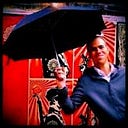A couple of years ago, I developed a game on how to reinvent your high street. Like any new method, it’s like assembling a Rubik's cube of existing methods in a different way. For the first workshop, we started with personas of people with different needs and of people who worked on the high street, with a basic layout of a high street.
After people introducing why they were there — a mixture of people working to tackle issues at a neighbourhood level and people wanting to learn new methods and meet people — I got people to start drawing places and actors you might find on a high street.
Not because I’m lazy, but because everyone’s high street is different and what people define as a high street is different too — it can be the high street where you live, where you work, it can even be the one you grew up in.
That way you get different high streets remixed into one. Of course, given the people living in London where the workshop took place, it will have an urban bias. It’s not meant to be a perfect representation of high streets across the country. Instead, it’s meant to get you thinking about the role of a librarian, but also a security guard of a supermarket, a pharmacist as well as a barista.
Some roles, like a community pharmacist, a library or a community champion, a commissioner wouldn’t bat an eyelid referring to, nor would a GP social prescribing.
How about people who aren’t based in a fixed space, who don’t have the recognised legitimacy to help people? What about the community warden walking up and down our streets, mixing with young and old alike? Who may know more about people’s issues than a council? What about a hairdresser who may know about people’s symptoms than a GP? What about a supermarket security guard who may know about the lives of people who sleep on the street than a homeless shelter?
Infrastructure for the high street
From this, we then looked at the infrastructure that could help get under the skin of the high street:
- What ambient data could help understand people’s movements and interactions, like football data, wifi data or jogging data?
- What relationships do people working in chains have with the high street versus people working in independents?
- How could you influence the skills development of employees working on high streets to be more dementia-friendly for example?
I then got people to visualise and include other types of actors that needn’t be buildings or people. People chose community cafes or supermarkets, but also a cyclist and a…duck! We also had places of worship, memorials, cycle lanes, buses and…air pollution.
What was most fascinating when people acted these behaviours out as they moved in relation to each other in the system? The duck became a powerful actor as it got people to interrogate how we use nature. The duck was in theory the only non-economic actor and wasn't a threat to any of the other actors. Yet it was an economic asset, as a pond with ducks increases the value of a house nearby!
